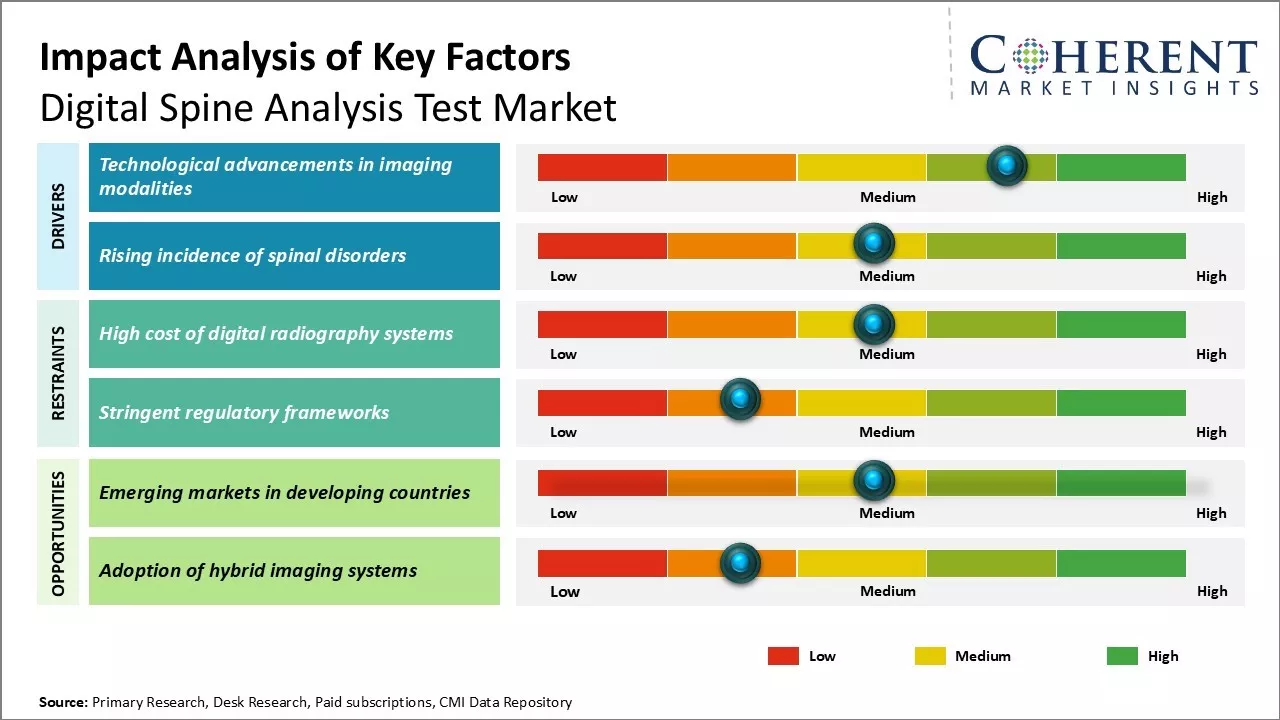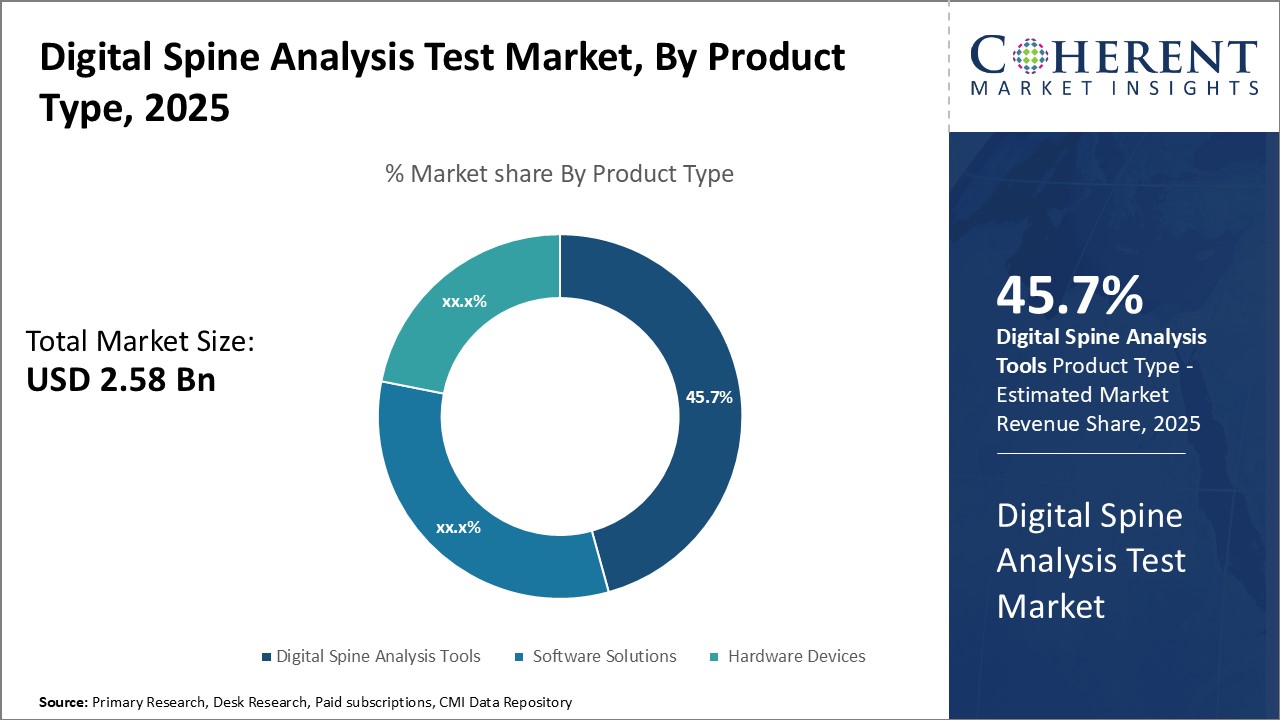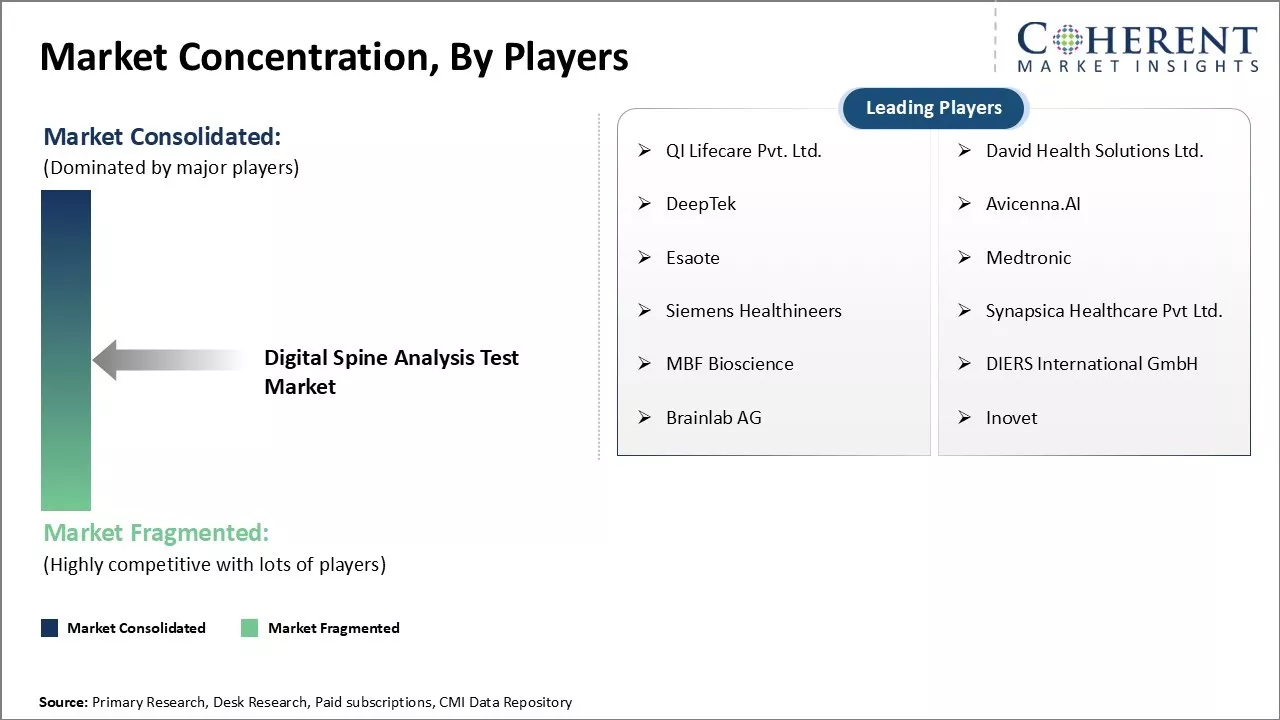Digital Spine Analysis Test Market Size and Trends
The digital spine analysis test market is estimated to be valued at USD 2.58 Billion in 2025 and is expected to reach USD 3.78 Billion by 2032, exhibiting a compound annual growth rate (CAGR) of 5.6% from 2025 to 2032.

Discover market dynamics shaping the industry: Download Free Sample
The global digital spine analysis test market is experiencing significant advancements driven by innovations in diagnostic imaging technologies, such as MRI and CT scans, which provide high-resolution images for better evaluation of spinal conditions. Key drivers include the increasing prevalence of spinal disorders, an aging population, and the rising demand for minimally invasive procedures. However, challenges such as high costs of advanced imaging systems and stringent regulatory approvals may restrain market growth.

Discover high revenue pocket segments and roadmap to it: Download Free Sample
Insights by Product Type - Fast and Accurate Diagnosis Drives Demand for Digital Spine Analysis Tools
In terms of product type, digital spine analysis tools segment is estimated to contribute the highest market share of 45.7% in 2025, owing to their ability to provide fast and accurate diagnosis of spinal disorders. Digital spine analysis tools utilize advanced imaging technologies like X-rays, CT scans, and MRIs to generate high-resolution 3D images of the spine. The accurate diagnostics enabled by digital tools empowers doctors to prescribe targeted treatment plans based on a thorough understanding of the condition. This translates to better clinical outcomes for patients.
Insights by Application - Reliance on Diagnostic Tests Drives Adoption of Software Solutions
In terms of application, diagnosis segment is estimated to contribute the highest market share of 56.1% in 2025, owing to hospitals and clinicians’ reliance on diagnostic tests for evaluating patients with suspected spine disorders. Software solutions have emerged as a convenient means to analyze the large volumes of imaging data generated through tests like CTs and MRIs. Their user-friendliness and flexible interface cater to the needs of healthcare providers, fueling their increased preference over traditional methods of diagnosis.
Insights by End User - Availability of Advanced Infrastructure Drives Hospitals Segment Growth
In terms of end user, hospitals segment is estimated to contribute the highest market share of 49.7% in 2025, due to the availability of advanced infrastructure and resources. Hospitals are typically equipped with the latest medical imaging and diagnostic technologies such as high-field MRI machines and multislice computed tomography scanners essential for comprehensive spinal evaluation. The concentration of multidisciplinary healthcare professionals and sophisticated facilities within hospitals provides a conducive environment for effectively utilizing digital tools.
Regional Insights

Need a Different Region or Segment? Download Free Sample
Regional Analysis: Digital Spine Analysis Test Market
Dominating Region: North America
North America is expected to dominate the digital spine analysis test industry with the highest market share of 42.6% in 2025, due to factors like a well-established healthcare infrastructure, high healthcare expenditure, presence of leading medical device companies, and favorable government policies that promote innovation.
Fastest-Growing Region: Asia Pacific
Asia Pacific exhibits the fastest growth with 24.7% of the market share in 2025 in the digital spine analysis test industry, due to increasing medical tourism, rising chronic disease prevalence, growing geriatric population, expanding healthcare sector with improving access and affordability, and government initiatives to modernize healthcare facilities.
Digital Spine Analysis Test Market Outlook for Key Countries
Increasing prevalence of degenerative spinal conditions in the U.S.
The U.S. digital spine analysis test industry is marked by early adoption of advanced technologies and a substantial patient population. The increasing number of elderly individuals is leading to a higher prevalence of degenerative spinal conditions, necessitating advanced diagnostic tools for effective management. For instance, according to data published by Medscape in September 2023, it was stated that as many as 80.5% of adults in the U.S. experience at least one episode of low back pain during their lifetime.
China’s advancements in healthcare infrastructure
China's digital spine analysis test industry is propelled by significant unmet medical needs, with a growing population suffering from spinal disorders. The "Healthy China 2030" initiative supports advancements in healthcare infrastructure and emphasizes the development of a skilled medical workforce, enhancing diagnostic capabilities and patient care.
Advanced diagnostic capabilities in Japan
Japan's digital spine analysis test industry is distinguished by its advanced diagnostic capabilities and commitment to precision medicine. The focus on personalized healthcare, combined with cutting-edge technologies, enhances treatment outcomes for spinal disorders, solidifying Japan's leadership in spine care innovation.
Enhanced accessibility to healthcare services in India
Enhanced accessibility to healthcare services in urban India is driving greater utilization of digital spine analysis tests. The establishment of Urban Primary Health Centers (U-PHCs) and initiatives like the National Urban Health Mission (NUHM) aim to improve healthcare delivery, facilitating timely diagnosis and treatment for spinal disorders amid a growing urban population.
Market Concentration and Competitive Landscape

Get actionable strategies to beat competition: Download Free Sample
Top Strategies Followed by Digital Spine Analysis Test Market Players
- Established players in the digital spine analysis test market focus heavily on research and development to introduce innovative products. Other major players adopt strategic partnership strategies to enhance their service offerings.
- Mid-level companies in the market focus on delivering cost-effective products to attract price-sensitive consumers. Emerging players like 24x Health specialized in specific spine conditions through niche products. It works with physical therapy clinics to gather real-world data on effectiveness of its innovative spinal braces using plant-based materials.
- Small-Scale Players: Emerging firms like Premia Spine specialize in niche products targeting specific spine conditions. They collaborate with physical therapy clinics to gather real-world data on the effectiveness of their innovative spinal braces made from plant-based materials. This approach not only addresses specific patient needs but also contributes to sustainable healthcare practices.
Emerging Startups in the Digital Spine Analysis Test Market
Some startups are developing cutting-edge technologies like advanced AI solutions for automated spine detection and classification using medical imaging. Anthropic is one such company developing generalizable AI tools to improve radiologist performance for spinal disorder diagnosis. Its algorithms studying large anonymized datasets have the potential to standardize diagnosis and monitoring of spine conditions.
Sustainability-focused startups also showcase innovative business models. BioCirce produces 3D bioprinted spinal implants using patient's own stem cells to prevent rejection. Its implants are designed to degrade gradually as new bone grows, reducing long-term implant-related issues.
Some startups effectively target niche markets. Key market players develop personalized spinal braces for Paralympic athletes using rapid prototyping. By addressing the unique needs of Paralympic sports involving spine, it contributes to enhancing their performance and safety.
Digital Spine Analysis Test Industry News
- On July 26, 2024, Alphatec (ATEC), a medical technology company, announced that it had launched EOS Insight, an end-to-end spine surgery platform powered by EOS scans and artificial intelligence (AI). The cloud-based software platform can be used to deliver crucial information throughout spine care. It allows access to a variety of point-of-care applications.
- On March 6, 2024, Medtronic, a global medical device company, announced that it had launched UNiD ePRO service in the U.S. This solution will change the way patient outcomes are collected for spine surgeons, reducing the burden on clinic staff and patients. Medtronic has partnered with OBERD, a leading practice intelligence data collection company, to provide spine surgeons with an electronic Patient Reported Outcomes (ePRO) system. The UNiD ePRO service integrates with a customer’s existing Electronic Medical Record (EMR) system in the hospital and clinic and the UNiD ASI platform to provide an unparalleled, seamless experience.
- In January 2023, DeepTek, a health tech startup in the Radiology AI space, announced the global launch of DeepSpine – an AI powered lumbar spine quantification and metrics tool designed to analyze MRI lumbar spine images. DeepSpine provides AI powered quantification and analysis tool for lumbar spine MRI studies and can assist radiologists, technologists, orthopedic surgeons, and physio experts to get objective automated quantification and other document of lumbar spine, adding value to the radiology reports and decongesting the radiology workflow.
Key Takeaways from Analyst
- The global digital spine analysis test market is driven by factors such as growing awareness about spine health issues, technological advancements in digital X-ray and MRI imaging modalities, and increasing demand for non-invasive diagnostic solutions. However, high cost of digital radiography equipment and dearth of trained medical professionals in developing regions may impede the market growth.
- Key players are focused on developing advanced spine analysis solutions integrated with artificial intelligence and cloud-based technologies. They are also emphasizing on strategic collaborations with hospitals, orthopedic clinics, and physical therapy centers to increase installed user base.
- North America currently dominates the market due to growing geriatric population and rising healthcare expenditure in the region. Asia Pacific is anticipated to be the fastest growing market led by expanding medical tourism industry and improving healthcare infrastructure in emerging economies of China and India.
Market Report Scope
Digital Spine Analysis Test Market Report Coverage
| Report Coverage | Details | ||
|---|---|---|---|
| Base Year: | 2024 | Market Size in 2025: | USD 2.58 Bn |
| Historical Data for: | 2020 To 2024 | Forecast Period: | 2025 To 2032 |
| Forecast Period 2025 to 2032 CAGR: | 5.6% | 2032 Value Projection: | USD 3.78 Bn |
| Geographies covered: |
|
||
| Segments covered: |
|
||
| Companies covered: |
QI Lifecare Pvt. Ltd., David Health Solutions Ltd., DeepTek, Avicenna.AI, Esaote, Medtronic, Siemens Healthineers, Synapsica Healthcare Pvt Ltd., MBF Bioscience, DIERS International GmbH, Brainlab AG, and Inovet |
||
| Growth Drivers: |
|
||
| Restraints & Challenges: |
|
||
Uncover macros and micros vetted on 75+ parameters: Get instant access to report
Market Dynamics
Market Driver - Technological advancements in imaging modalities
Advancements in imaging technologies, such as next-generation CT and MRI scanners, are key drivers for the digital spine analysis test industry. These innovations enable high-resolution imaging for detailed visualization of spinal structures, facilitating early and accurate disease detection. Enhanced capabilities, like multi-detector arrays in CT and powerful MRI sequences, improve diagnostic accuracy, significantly benefiting patient outcomes in spinal care. Advancements in imaging continue to expand the role of the digital spine analysis test market. The potential to obtain higher resolution functional and molecular details will strengthen diagnostic capabilities for early detection and management of spinal disorders.
Market Challenge – Stringent regulatory framework
The digital spine analysis test market faces significant challenges due to stringent regulatory frameworks governing medical devices. Regulatory bodies, such as the U.S. Food and Drug Administration, impose rigorous approval processes for spinal devices, requiring extensive clinical data to ensure safety and efficacy. This can lead to delays in product launches, increased costs for manufacturers, and potential barriers to innovation in spinal diagnostics.
Market Challenge – Emerging markets in developing countries
One of the key opportunities for the digital spine analysis test market lies in emerging markets within developing countries. As healthcare infrastructure improves across Asia Pacific and Latin America, demand for advanced spinal diagnostics will rise. While North America dominate revenues, developing economies like India, Indonesia, China, and Japan are projected to see significant growth as financial capacities increase, driving investments in digital technologies tailored to local needs.
Key Stakeholders of Market
What does Growth in the Digital Spine Analysis Test Industry mean for Different Stakeholders?
The digital spine analysis test industry has multiple players with varied designations and offers multiple opportunities based on their scope of operations.
|
Key Medical Devices Stakeholder |
Opportunities Due to Digital Spine Analysis Test Industry Growth |
|
Retail Pharmacies |
Offering medical devices for home use, such as blood glucose monitors and digital thermometers, expanding product offerings and customer care services. |
|
Medical Device Manufacturers |
Expansion of product lines to include innovative devices such as wearables, smart implants, and AI-driven diagnostic tools. |
|
Healthcare Providers |
Opportunities to adopt and integrate cutting-edge medical devices into patient care, improving outcomes and expanding service offerings. |
|
Biotech Firms |
Collaborating on the development of combination products, such as drug-device combinations, offering new treatment options and expanding markets. |
|
Regulatory Affairs Specialists |
Growing demand for expertise in navigating the complex regulatory landscape for medical device approvals, ensuring compliance with global standards. |
|
Supply Chain and Logistics Providers |
Managing the distribution of sensitive and high-value medical devices, including ensuring compliance with medical regulations and standards. |
|
Medical Device Consultants |
Providing strategic guidance on product development, regulatory compliance, and market entry for medical device companies. |
|
Healthcare Training Institutions |
Expanding training programs to include the use of advanced medical devices, preparing healthcare professionals for the latest technological advancements. |
Uncover macros and micros vetted on 75+ parameters: Get instant access to report
Market Segmentation
- By Product Type Insights (Revenue, USD Bn, 2020 - 2032)
-
- Digital Spine Analysis Tools
- Software Solutions
- Hardware Devices
- By Application Insights (Revenue, USD Bn, 2020 - 2032)
-
- Diagnosis
- Treatment
- Preoperative Assessment
- By End User Insights (Revenue, USD Bn, 2020 - 2032)
-
- Hospitals
- Specialty Clinics
- Ambulatory Surgery Centers (ASCs)
- Others
- Regional Insights (Revenue, USD Bn, 2020 - 2032)
-
- North America
- U.S.
- Canada
- Latin America
- Brazil
- Argentina
- Mexico
- Rest of Latin America
- Europe
- Germany
- U.K.
- Spain
- France
- Italy
- Russia
- Rest of Europe
- Asia Pacific
- China
- India
- Japan
- Australia
- South Korea
- ASEAN
- Rest of Asia Pacific
- Middle East
- GCC Countries
- Israel
- Rest of Middle East
- Africa
- South Africa
- North Africa
- Central Africa
- North America
- Key Players Insights
-
- QI Lifecare Pvt. Ltd.
- David Health Solutions Ltd.
- DeepTek
- AI
- Esaote
- Medtronic
- Siemens Healthineers
- Synapsica Healthcare Pvt Ltd.
- MBF Bioscience
- DIERS International GmbH
- Brainlab AG
- Inovet
Share
Share
About Author
Komal Dighe is a Management Consultant with over 8 years of experience in market research and consulting. She excels in managing and delivering high-quality insights and solutions in Health-tech Consulting reports. Her expertise encompasses conducting both primary and secondary research, effectively addressing client requirements, and excelling in market estimation and forecast. Her comprehensive approach ensures that clients receive thorough and accurate analyses, enabling them to make informed decisions and capitalize on market opportunities.
Missing comfort of reading report in your local language? Find your preferred language :
Transform your Strategy with Exclusive Trending Reports :
Frequently Asked Questions
EXISTING CLIENTELE
Joining thousands of companies around the world committed to making the Excellent Business Solutions.
View All Our Clients
